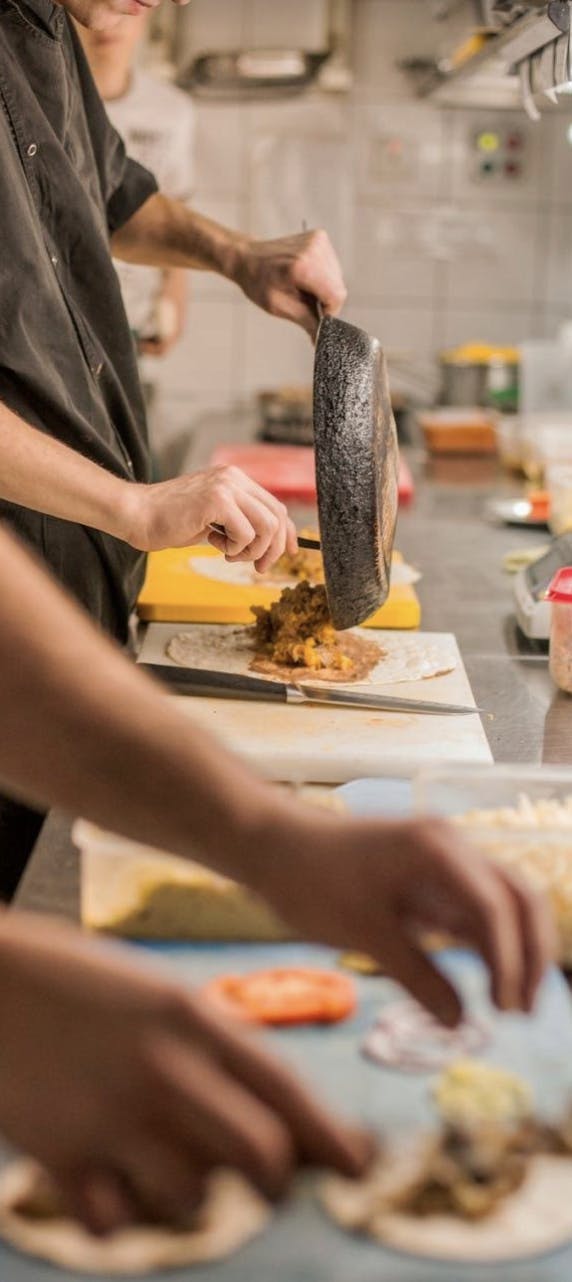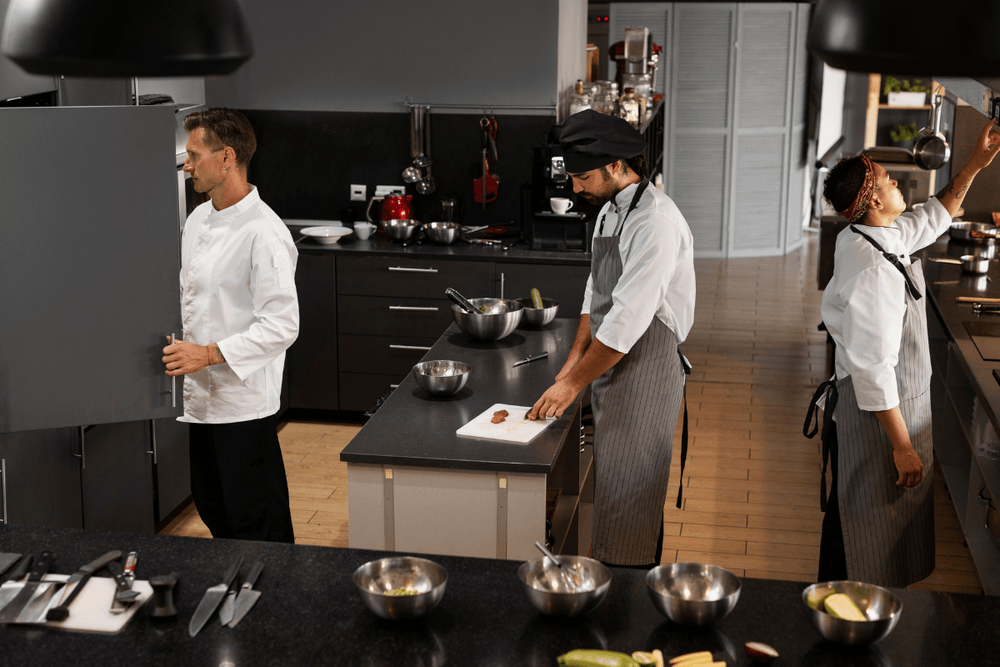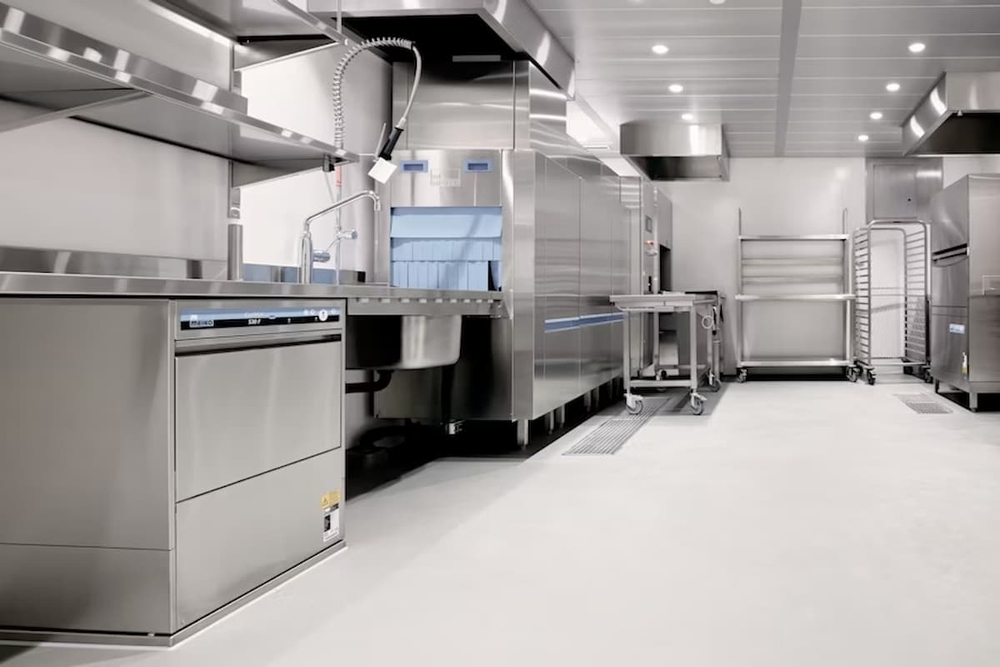Unlocking catering kitchen logistics: Setting up the right kitchen for delivery success
Table of Contents
CloudKitchens
How many tacos can be delivered from a 1000sqft restaurant?
The same amount as a 200sqft ghost kitchen.
Mastering catering kitchen logistics means navigating much more than just recipes and timing, it requires orchestrating equipment, staff, workflow, and safe transport to ensure every event runs seamlessly from prep to plate.
This guide breaks down the essentials of optimizing your catering kitchen for modern delivery demands, covering everything from smart equipment layouts and role assignments to transport tactics, food safety measures, and leveraging digital tools for efficiency and scale.
Whether you’re refining the processes of an established catering business or launching a new delivery-first venture, an optimized kitchen setup is the cornerstone of reliability, consistency, and customer satisfaction.
Understanding catering kitchen logistics
Catering kitchen logistics encompasses all the planning, processes, and operations required to ensure food is prepared, stored, and delivered to clients or events with maximum efficiency and quality.
Unlike restaurant kitchens that serve guests onsite, catering kitchens must synchronize production with strict timelines, transport food over varying distances, and guarantee safety throughout transit and service.
What is logistics in catering?
At its core, logistics in catering means managing the journey of food, ingredients to final service, ensuring each link of the chain works seamlessly. Key areas include:
- Procurement and inventory: Sourcing, storing, and rotating ingredients to avoid shortages or spoilage.
- Production planning: Scheduling prep, cooking, packaging, and loading based on event timing and order size.
- Workflow coordination: Dividing responsibilities between chefs, packers, drivers, and servers.
- Delivery dispatch: Ensuring timely departure, temperature control, and route optimization.
- Onsite setup and support: Quick assembly, service, and post-event cleanup.
Strong catering logistics mean fewer mistakes, reduced waste, reliable delivery, and higher client satisfaction.
Read more: 20 Catering trends to improve your business success!
The right kitchen setup for delivery
Designing the perfect kitchen setup for delivery is about more than just having enough space and the right appliances, it’s about optimizing every stage of production for efficiency, safety, and consistency.
Designing the optimal kitchen for catering and delivery
The foundation of effective catering logistics is a thoughtfully designed kitchen. Your layout, equipment, and workflows should be tailored for high-volume prep, safe storage, and efficient packing for transit. Key principles include:
- Zoning: Separate areas for receiving, prep, cooking, plating/packing, and cleaning to prevent cross-contamination and congestion.
- Efficient flow: Equipment, workstations, and storage should align with your production “flow” — from raw ingredients to ready-to-serve dishes.
- Flexible workspaces: Mobile tables, movable shelving, and modular equipment support diverse menus and event needs.
- Specialized equipment: Blast chillers, holding ovens, commercial fridges, vacuum sealers, and insulated hot boxes help maintain food quality.
Pro Tip: A good restaurant business plan not only saves time, but also reduces stress and keeps your operation compliant with health codes and regulations.
Sample kitchen zones
| Zone | Main Functions |
| Receiving/Storage | Ingredient drop-off, inventory, chilling |
| Prep Area | Washing, chopping, marinating |
| Cooking Line | Ovens, stoves, grilling, bulk cooking |
| Plating & Packing | Portioning, packaging, labeling |
| Loading Area | Staging orders for pickup/delivery |
| Cleaning/Sanitation | Dishwashing, waste handling |
Read more: Maximizing efficiency: How catering software solutions can streamline your business operations
Essential equipment for efficient catering kitchens
Having the right tools is critical for streamlined logistics, food safety, and speed. Core equipment for a catering kitchen focused on delivery should include:
- Commercial ovens and ranges: For batch cooking and reheating dishes at scale.
- Blast chillers/freezers: Rapidly cool cooked foods for safe storage and transport.
- Hot holding cabinets: Maintain food at safe temperatures before serving or packing.
- Insulated carriers and food pans: Ensure food arrives hot, cold, or fresh as required.
- Large prep tables and cutting stations: Enable multiple staff to work efficiently.
- Label printers or systems: For order accuracy and allergy/safety info.
- Cleaning/sanitizing stations: For compliance and quick turnover.
- Packaging supplies: Sturdy containers, trays, wraps, and utensils for safe, attractive presentation.
Optimizing your kitchen with the right mix of scalable equipment ensures every order moves swiftly from prep to delivery, even during your busiest seasons.
Read more: Restaurant equipment list: A guide
How to transport cooked food for catering
Getting cooked food to clients safely and on time is a logistical art and science. Here’s how the best catering businesses do it:
1. Packaging for freshness and safety
- Use insulated food carriers for hot dishes, ensuring temperatures stay above 140°F (60°C).
- Pack cold and perishable foods in coolers or refrigerated carriers.
- Seal items tightly to prevent leaks, spills, and contamination.
- Choose packaging materials that retain flavors and textures.
Read more: Tips for proper food delivery packaging: A guide for restaurants
2. Labeling and organization
- Clearly label every dish with event name, contents, and special instructions.
- Group items by delivery route or event for faster loading and drop-off.
3. Route planning
- Map out the most efficient delivery routes, accounting for traffic, weather, and venue access.
- Use GPS and real-time tracking for updates.
4. Timing and communication
- Schedule dispatch to ensure food arrives fresh and at the correct time.
- Stay in constant contact with drivers and onsite staff to handle any issues.
Tips for special challenges
- Deliver sauces and garnishes separately to preserve textures.
- Reheat or finish-cook some items at the event site if possible and safe.
- Use dolly carts or lifts for heavy or bulky deliveries, protecting both staff and food.
Read more: How corporate catering can boost Ghost Kitchens?
How CloudKitchens elevates catering kitchen logistics and delivery setup
CloudKitchens offers the ultimate platform for catering businesses seeking to streamline logistics, scale their brand, and focus on what matters most — amazing food and service. With ready-to-use, health code-compliant kitchens in prime locations, you can launch or expand your catering operation without costly buildouts or long leases.
Each facility is optimized for rapid production, secure storage, and easy hand-off to delivery staff, making bulk orders, special diets, and tight timeframes easy to manage. CloudKitchens’ professional infrastructure includes state-of-the-art equipment, modular workspaces, and rigorous sanitation, all maintained by on-site teams so you can focus on growth and client service.
Integrated technology lets you manage orders, monitor inventory, and optimize deliveries from a single dashboard, while compliance experts help you meet all health, safety, and regulatory requirements. Whether you’re delivering office lunches, wedding feasts, or meal kits, partnering with CloudKitchens gives you the flexibility and scale to meet demand with confidence.
Ready to revolutionize your catering kitchen logistics and delivery? Contact CloudKitchens now and discover how the right kitchen setup can power your path to lifelong catering success.
DISCLAIMER: This information is provided for general informational purposes only and the content does not constitute an endorsement. CloudKitchens does not warrant the accuracy or completeness of any information, text, images/graphics, links, or other content contained within the blog content. We recommend that you consult with financial, legal, and business professionals for advice specific to your situation.
More insights & stories
There’s more where that came from.
Get in the know and check out our additional insights




